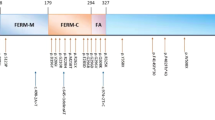Abstract
Infant nystagmus sydrome presents as involuntary eye movement disorder and can affect seriously ocular function. We performed a retrospective study of clinical data and FRMD7 genetic test results in 12 cases of infantile nystagmus syndrome to correlate waveform, stereopsis, and visual acuity. The patients (age 6.40±2.67 years) had FRMD7 mutations as follows: missense in eight cases, shear in two cases, frameshift in one case, and non-frameshift in one case. Horizontal jerk waveform was observed in six cases, versus horizontal pendulum in five cases and dual jerk in one case. The uncorrected visual acuity (24 eyes) was 0.21±0.12, compared with a corrected visual acuity (24 eyes) of 0.32±0.14. All patients had simultaneous perception, versus fusion function in 10 cases (83.33%) and stereoscopic vision in seven cases (58.33%) using the synoptophore. Eleven cases (91.67%) detected the stereo fly, compared with five cases (41.67%) for stereoscopic circles and seven cases (58.33%) for stereoscopic animals by Titmus test. Stereoscopic vision using the synoptophore did not correlate with the frequency, amplitude, or intensity of nystagmus or with corrected binocular visual acuity. The infantile nystagmus syndrome with FRMD7 mutations in our cases was caused primarily de novo and missense mutations. Visual acuity and binocular visual function were significant impaired, and the waveform was generally horizontal jerk. Also, an infrared videonystagmogram can record the frequency, amplitude, and intensity of nystagmus accurately.
Similar content being viewed by others
References
Abadi, R.V. (1991). Sensory and Motor Aspects of Congenital Nystagmus. (North Holland: Elsevier science publishers RV), pp. 249–256.
Abadi, R.V., and Dickinson, C.M. (1986). Waveform characteristics in congenital nystagmus. Doc Ophthalmol 64, 153–167.
Ahmedbegovic, P.M1., Alikadic-Husovic, A., Griševic, S., Pašalic, A., Pidro, A., Ratkovic, M., Bohac, M., Gabric, N., and Gojak, R. (2016). Efficacy and safety of iris-supported phakic lenses (Verisyse) for treating moderately high myopia. Med Glas (Zenica) 13, 25–30.
Dell’Osso, L.F., and Daroff, R.B. (1975). Congenital nystagmus waveforms and foveation strategy. Doc Ophthalmo 139, 155–182.
Denis, D., Girard, N., Toesca, E., Zanin, E., Gambarelli, N., Lebranchu, P., and Mancini, J. (2010). Apport de l’IRM dans les nystagmus congénitaux. J Français d’Ophtalmologie 33, 189–205.
Du, W., Bu, J., Dong, J., Jia, Y., Li, J., Liang, C., Si, S., and Wang, L. (2011). A novel flame shift mutation in FRMD7 causes X-linked idiopathic congenital nystagmus in a Chinese family. Mol Vis 17, 2765–2768.
Fang, S., Guo, X., Jia, X., Xiao, X., Li, S., and Zhang, Q. (2008). Novel GPRl43 mutations and clinical characteristics in six Chinese families with X-linked ocular albinism. Mol Vis 14, 1974–1982.
Fu, V.L., Bilonick, R.A., Felius, J., Hertle, R.W., and Birch, E.E. (2011). Visual acuity development of children with infantile nystagmus syndrome. Invest Ophthalmol Vis Sci 52, 1404–1411.
Gottlob, I. (1997). Infantile nystagmus. Development documented by eye movement recordings. Invest Ophthalmol Vis Sci 38, 767–773.
He, X., Gu, F., Wang, Y., Yan, J., Zhang, M., Huang, S., and Ma, X. (2008). A novel mutation in FRMD7 causing X-linked idiopathic congenital nystagmus in a large family. Mol Vis 14, 56–60.
Hertle, R.W. (2001). A classification of eye movement abnormalities and strabismus (CEMAS). Report of a National Eye Institute Sponsored Workshop from the committee for the Classification of Eye Movement Abnormalities and Strabismus (CEMAS) Workshop. pp. 1–56.
Hertle, R.W. (2006). Nystagmus and ocular oscillations in infancy and childhood. In Handbook of pediatric neuro-ophthalmology, K.W. Wright, P.H. Spiegel, and L.S. Thompson, ed. (New York: Springer), pp. 289–323.
Khanal, S., Pokharel, A., and Kandel, H. (2016). Visual deficits in Nepalese patients with oculocutaneous albinism. J Optom 9, 102–109.
Li, N., Wang, L., Cut, L., Zhang, L., Dai, S., Li, H., Chen, X., Zhu, L., Hejtmancik, J.F., and Zhao, K. (2008). Five novel mutations of the FRMD7 gene in Chinese families with X-linked infantile nystagmus. Mol Vis 14, 733–738.
Li, N., Wang, X., Wang, Y., Wang, L., Ying, M., Han, R., Liu, Y., and Zhao, K. (2011). Investigation of the gene mutations in two Chinese families with X-linked infantile nystagmus. Mol Vis 17, 461–468.
Ogata, M., Ukai, K., and Kawai, T. (2005). Visual fatigue in congenital nystagmus caused by viewing images of color sequential projectors. J Disp Technol 1, 314–320.
Patton, M.A., Jeffery, S., Lee, N., and Hogg, C. (1993). Congenital nystagmus cosegregating with a balanced 7;15 translocation. J Med Genets 30, 526–528.
Stayte, M., Reeves, B., and Wortham, C. (1993). Ocular and vision defects in preschool children. British J Ophthalmology 77, 228–232.
Sarvananthan, N., Surendran, M., Roberts, E.O., Jain, S., Thomas, S., Shah, N., Proudlock, F.A., Thompson, J.R., McLean, R.J., Degg, C., Woodruff, G., and Gottlob, I. (2009). The prevalence of nystagmus: the leicestershire nystagmus survey. Invest Ophthalmol Vis Sci 50, 5201–5206.
Teitel, A.D., and Rubin, J. (2008). Horizontal pendular nystagmus in a patient with ocular albinism. N Engl J Med 359, e5.
Thomas, S., Proudlock, F.A., Sarvananthan, N., Roberts, E.O., Awan, M., McLean, R., Surendran, M., Kumar, A.S., Farooq, S.J., Degg, C., Gale, R.P., Reinecke, R.D., Woodruff, G., Langmann, A., Lindner, S., Jain, S., Tarpey, P., Raymond, F.L., and Gottlob, I. (2008). Phenotypical characteristics of idiopathic infantile nystagmus with and without mutations inFRMD7. Brain 131, 1259–1267.
Watkins, R.J., Patil, R., Goult, B.T., Thomas, M.G., Gottlob, I., and Shackleton, S. (2013). A novel interaction between FRMD7 and CASK: evidence for a causal role in idiopathic infantile nystagmus. Human Mol Genets 22, 2105–2118.
Acknowledgements
This work was supported by the capital special features of the Beijing municipal science and technology commission (Z151100004015072).
Author information
Authors and Affiliations
Corresponding author
Rights and permissions
About this article
Cite this article
Bai, D., Shi, W., Qi, Z. et al. Clinical feature and waveform in infantile nystagmus syndrome in children with FRMD7 gene mutations. Sci. China Life Sci. 60, 707–713 (2017). https://doi.org/10.1007/s11427-017-9089-5
Received:
Accepted:
Published:
Issue Date:
DOI: https://doi.org/10.1007/s11427-017-9089-5




